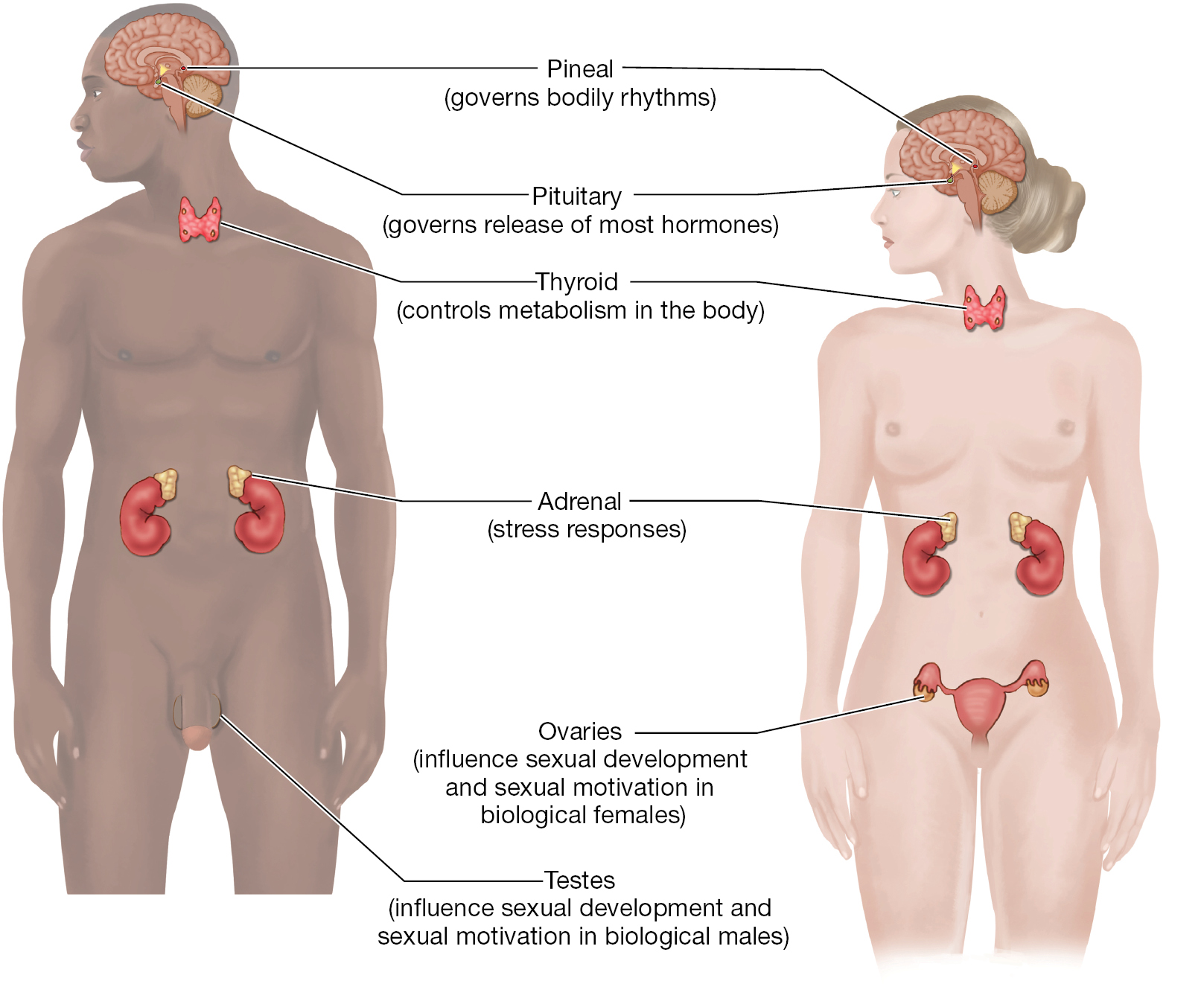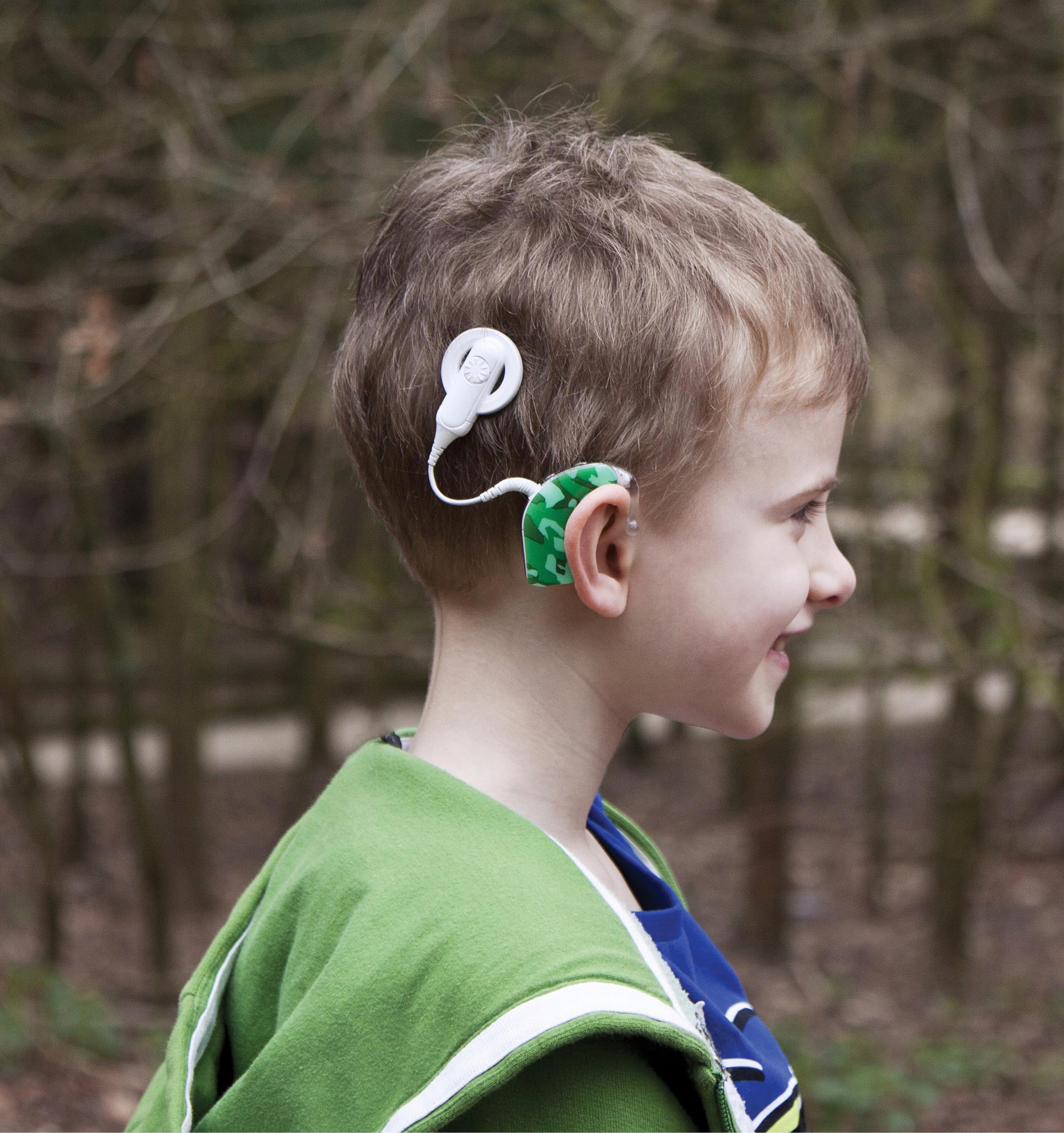LEARNING GOAL
Explain how the endocrine system and the nervous system work together to regulate psychological activity.
LEARNING GOAL
Explain how the endocrine system and the nervous system work together to regulate psychological activity.
Your body changed when you went through puberty. You might have experienced a growth spurt, you sprouted body hair in new places, and perhaps your skin developed pimples. All of these changes were due to the endocrine system, which is a communication network that influences many aspects of your body. The endocrine system also influences your mental activity and behavior, perhaps making you feel stressed when you are studying for exams.
The nervous system and the endocrine system work together in regulating psychological activity. For instance, your brain receives information from your nervous system about potential threats. Your brain communicates with your endocrine system to prepare you to deal with those threats—for example, by directing energy to help you avoid potential injury. The main difference between the two systems is their forms of communication. The nervous system uses very fast electrochemical signals when neurons release neurotransmitters. By contrast, the endocrine system uses a relatively slower method of communication, releasing chemicals from glands.
Hormones are the chemicals that are released into the bloodstream by endocrine glands. The endocrine glands include the pineal gland, the adrenal glands, the pituitary gland, the thyroid, and the testes or ovaries (Figure 2.29 on p. 80). Once released, hormones travel through the bloodstream until they reach their target tissues. When they arrive, the hormonal messages trigger bodily activity that affects your mental activity and behavior. Because they travel through the bloodstream, hormones can take from seconds to hours to have an effect. These effects can last for a long time and affect multiple body regions.

The pineal gland is in the brain right above the cerebellum and at the back tip of the corpus callosum. It governs bodily rhythms. The pituitary gland is just above and to the left of the pons. It governs the release of most hormones. The thyroid gland is in the neck just above the collar bone. It controls metabolism in the body. The adrenal glands are attached to the top of the kidneys and control stress responses. The ovaries are just found in females on both sides of the vaginal canal. They influence sexual development and sexual motivation in biological females. The testes are only found in males and are below the penis. They influence sexual development and sexual motivation in biological males.
FIGURE 2.29 The Major Endocrine Glands
The glands in the endocrine system work with the nervous system by releasing chemicals that influence mental activity and behavior. Which gland controls metabolism in the body?
Hormones and Sexual Development One example of hormonal influence is sexual development. The main endocrine glands influencing sexual behavior are the gonads, which are the sex glands used for reproduction. In males the gonads are the testes, and in females the gonads are the ovaries (see Figure 2.29). Although people often talk about “male” and “female” hormones, males and females produce both types of hormones in the gonads. What differs is the quantity produced. Androgens, such as testosterone, tend to be greater in males. Estrogens, such as estradiol, tend to be greater in females. Gonadal hormones influence the development of secondary sex characteristics (for example, breast development in females and growth of facial hair in males). Gonadal hormones also influence adult sexual behavior.
Hormones and Physical Growth Growth hormone (GH) prompts bone, cartilage, and muscle tissue to grow or helps them regenerate after injury. Since the 1930s, some people have used GH to increase body size and strength. Many athletes have sought a competitive advantage by using GH. For example, athletes competing in a wide array of sports have used GH to try to gain strength and enhance performance. Although people who are deficient in GH benefit from taking it, there is little evidence that taking GH increases the muscle strength or aerobic capacity of those who have normal levels to begin with (Holt & Ho, 2019). Indeed, GH is more likely to cause serious health problems than to make you a better athlete (Sergeeva et al., 2019). The use of GH is banned in most athletic competitions, including the Olympics. Sports and health are two of the major occupational fields that rely on an understanding of biological psychology, as explored in the Putting Psychology to Work feature on page 81.
HOW CAN UNDERSTANDING BIOLOGICAL PSYCHOLOGY HELP YOU IN YOUR JOB?
In many occupations, a strong understanding of the body and brain is vital. Read on for more information about the role of biological psychology in two important industries: healthcare and health-related areas.

The text at the top of the page reads How can understanding Biological Psychology Help you in your Job. In many occupations, a strong understanding of the body and brain is vital. Read on for more information about the role of biological psychology in two important industries: healthcare and health-related areas. A photo of a pharmacist wearing a coat and taking some medicine from a medicine rack is shown. The adjacent text reads, One of the largest and fastest-growing areas of employment in health care. As life spans increase and populations age, more and more people need medical assessments and treatments. As people get older, they often have to take many medications. If you work in a pharmacy, you need to understand how neurotransmitters work. Knowing that different drugs might have their effects through the same neurotransmitters will help you explain to patients why they need to be careful if they are taking multiple medications. For example, you can say why they should avoid mixing alcohol with other drugs that have their effects through the activation of GABA receptors. In pharmaceutical sales, knowledge from this chapter can help you explain why a particular drug is a better choice for your clients. A photo shows a side view of a young boy wearing a hearing machine. The adjacent text reads, Consider also other people who work in health-related areas. For example, specialists in the new field of neuroprosthetics collaborate with medical professionals to develop technologies that help people with neurological disorders and limb differences regain function (Leuthardt e t a l., 2014; see also www.lukehand.org). If you are a physical therapist, knowing about the functions of different brain regions will help you understand the problems that a client with damage to a specific brain area is likely to experience. In non-health-related careers, neuro marketers use E E G and f M R I recordings to predict consumer behavior in response to particular advertisements and products. This neuroscientific approach has been somewhat successful, with f M R I activity of brain reward regions predicting actual consumer behavior (Venkatraman e t al., 2015).
1 One of the largest and fastest-growing areas of employment is health care. As life spans increase and populations age, more and more people need medical assessments and treatments. As people get older, they often have to take many medications. If you work in a pharmacy, you need to understand how neurotransmitters work. Knowing that different drugs might have their effects through the same neurotransmitters will help you explain to patients why they need to be careful if they are taking multiple medications. For example, you can say why they should avoid mixing alcohol with other drugs that have their effects through activation of GABA receptors. In pharmaceutical sales, knowledge from this chapter can help you explain why a particular drug is a better choice for your clients.

The text at the top of the page reads How can understanding Biological Psychology Help you in your Job. In many occupations, a strong understanding of the body and brain is vital. Read on for more information about the role of biological psychology in two important industries: healthcare and health-related areas. A photo of a pharmacist wearing a coat and taking some medicine from a medicine rack is shown. The adjacent text reads, One of the largest and fastest-growing areas of employment in health care. As life spans increase and populations age, more and more people need medical assessments and treatments. As people get older, they often have to take many medications. If you work in a pharmacy, you need to understand how neurotransmitters work. Knowing that different drugs might have their effects through the same neurotransmitters will help you explain to patients why they need to be careful if they are taking multiple medications. For example, you can say why they should avoid mixing alcohol with other drugs that have their effects through the activation of GABA receptors. In pharmaceutical sales, knowledge from this chapter can help you explain why a particular drug is a better choice for your clients. A photo shows a side view of a young boy wearing a hearing machine. The adjacent text reads, Consider also other people who work in health-related areas. For example, specialists in the new field of neuroprosthetics collaborate with medical professionals to develop technologies that help people with neurological disorders and limb differences regain function (Leuthardt e t a l., 2014; see also www.lukehand.org). If you are a physical therapist, knowing about the functions of different brain regions will help you understand the problems that a client with damage to a specific brain area is likely to experience. In non-health-related careers, neuro marketers use E E G and f M R I recordings to predict consumer behavior in response to particular advertisements and products. This neuroscientific approach has been somewhat successful, with f M R I activity of brain reward regions predicting actual consumer behavior (Venkatraman e t al., 2015).
2 Consider also other people who work in health-related areas. For example, specialists in the new field of neuroprosthetics collaborate with medical professionals to develop technologies that help people with neurological disorders and limb differences regain function (Leuthardt et al., 2014; see also www.lukehand.org). If you are a physical therapist, knowing about the functions of different brain regions will help you understand the problems that a client with damage to a specific brain area is likely to experience. In non-health-related careers, neuromarketers use EEG and fMRI recordings to predict consumer behavior in response to particular advertisements and products. This neuroscientific approach has been somewhat successful, with fMRI activity of brain reward regions predicting actual consumer behavior (Venkatraman et al., 2015).
LEARNING GOAL CHECK: REVIEW